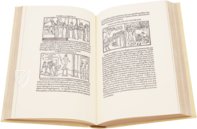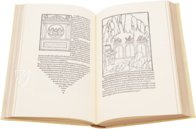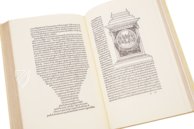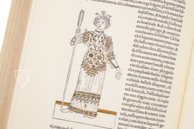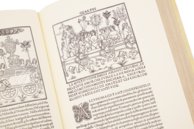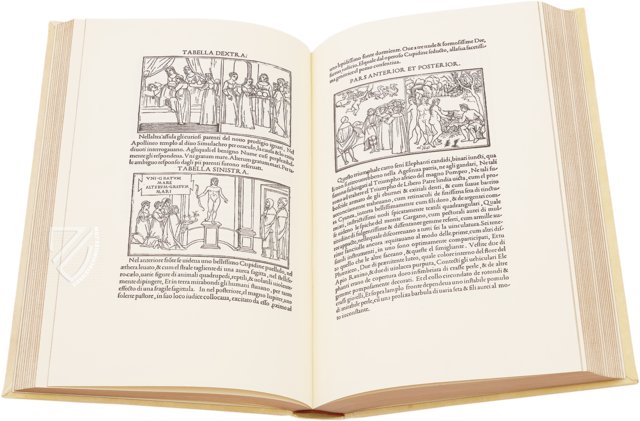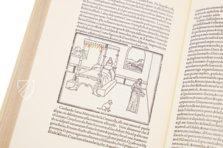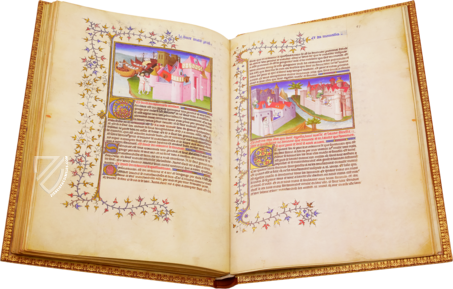Hypnerotomachia Poliphili
(1,000€ - 3,000€)
This is one of the world’s most coveted and artistically refined incunabula, early printed books originating before 1501. It originates from the Aldine Press, the famous Venetian printing house of Aldo Manuzio (1449/52–1515), Latinized Aldus Manutius, a Venetian humanist, scholar, and educator. Although written anonymously, an acrostic formed by the first decorative initial in each chapter in the original Italian edition indicates the Domincan friar Francesco Colonna (1433/1434–1527), Latinized Franciscus Columna, is the author. It is a chivalric romance, but takes on the unusual form of a dream within a dream, as the protagonist, Poliphilo, attempts to overcome the rejection of his beloved Polia. 192 superbly detailed woodcuts, possibly by the painter Giovanni Bellini (ca. 1430–1516), clearly illustrate the confused dreams of Poliphilo. Appearing in numerous editions and translations, this is one of the most popular literary works of the Renaissance.
Hypnerotomachia Poliphili
An incunabulum is an early printed book originating before 1501, they mark the genesis of modern book printing and are highly coveted by bibliophiles. The specimen at hand is one of the most beautiful, sought-after incunabula ever printed: a courtly romance presented as a mysterious allegory. Its title in English is Poliphilo's Strife of Love in a Dream or alternately The Dream of Poliphilus and it was printed in November of 1499 by Aldo Manuzio (1449/52–1515), Latinized Aldus Manutius, a Venetian humanist, scholar, educator, and founder of the Aldine Press, famous inter alia for the introduction of Italics and the small “octavo” format resembling a modern paperback and designed to be portable. The popularity of the tale has necessitated numerous translations and editions over the centuries.
Inspiration for Carl Jung
The author of the book is anonymous, but an acrostic formed by the first decorative initial in each chapter in the original Italian edition reads: POLIAM FRATER FRANCISCVS COLVMNA PERAMAVIT, which means "Brother Francesco Colonna has dearly loved Polia". As such, the Domincan friar Francesco Colonna (1433/1434–1527), Latinized Franciscus Columna, is typically credited with authoring the work. The work has been widely praised, and not just by bibliophiles – famed Swiss psychologist Carl Jung (1875–1961) admired the work and credited it for inspiring his theory of archetypes.
Dreams within Dreams
The protagonist, Poliphilo, is shunned by his beloved, Polia, and endures a restless, dream-filled night. In his dream, he is lost in a forest where he encounters dragons, wolves, and maidens as well as various architectures. He escapes and fall asleep once more. Poliphilo now awakes to a dream within a dream, and is taken by nymphs to meet their queen. There he declares his love for Polia and is taken by two of the nymphs to choose among three gates, choosing the third. His beloved Polia is within and the reunited couple are taken to a temple to be engaged after they are celebrated by five triumphal processions. A barge piloted by Cupid then takes them to the island of Cythera, which is filled with orange trees and marble statues and where another triumphal procession awaits to celebrate their union. At this point, Polia’s voice interrupts the narrative and describes Poliphilo’s infatuation from her point of view before rejecting him again. However, Cupid appears to her in a vision, compelling her to return to Poliphilo, who has fallen into a deathlike swoon but is revived by Polia’s kiss. Their love is now blessed by Venus and, united at last, he tries to embrace Polia, but she vanishes in a mist, ending the dream and waking up Poliphilo. All of these events are illustrated by 192 superbly detailed woodcuts, possibly by the painter Giovanni Bellini (ca. 1430–1516). The scenes’ architectural settings in particular are, aside from being artistically refined, excellent insights into the aesthetics of Greek and Roman antiquities that were valued during the Renaissance.
Codicology
- Alternative Titles
- Poliphilo's Strife of Love in a Dream
- Size / Format
- 478 pages / 33.0 × 21.5 cm
- Origin
- Italy
- Date
- December 1499
- Epochs
- Style
- Genre
- Language
- Illustrations
- 192 woodcuts
- Content
- Poem
- Artist / School
- Francesco Columna (author)
Aldo Manuzio (printer)
Giovanni Bellini (woodcuts)
#1 Hypnerotomachia Poliphili
(1,000€ - 3,000€)
- Treatises / Secular Books
- Apocalypses / Beatus
- Astronomy / Astrology
- Bestiaries
- Bibles / Gospels
- Chronicles / History / Law
- Geography / Maps
- Saints' Lives
- Islam / Oriental
- Judaism / Hebrew
- Single Leaf Collections
- Leonardo da Vinci
- Literature / Poetry
- Liturgical Manuscripts
- Medicine / Botany / Alchemy
- Music
- Mythology / Prophecies
- Psalters
- Other Religious Books
- Games / Hunting
- Private Devotion Books
- Other Genres
- Afghanistan
- Armenia
- Austria
- Belgium
- Colombia
- Croatia
- Cyprus
- Czech Republic
- Denmark
- Egypt
- Ethiopia
- France
- Germany
- Greece
- Hungary
- India
- Iran
- Iraq
- Israel
- Italy
- Japan
- Lebanon
- Luxembourg
- Mexico
- Morocco
- Netherlands
- Palestine
- Peru
- Poland
- Portugal
- Russia
- Serbia
- Spain
- Sri Lanka
- Sweden
- Switzerland
- Syria
- Turkey
- Ukraine
- United Kingdom
- United States
- Uzbekistan
- Aboca Museum
- Ajuntament de Valencia
- Akademie Verlag
- Akademische Druck- u. Verlagsanstalt (ADEVA)
- Aldo Ausilio Editore - Bottega d’Erasmo
- Alecto Historical Editions
- Alkuin Verlag
- Almqvist & Wiksell
- Amilcare Pizzi
- Andreas & Andreas Verlagsbuchhandlung
- Archa 90
- Archiv Verlag
- Archivi Edizioni
- Arnold Verlag
- ARS
- Ars Magna
- ArtCodex
- AyN Ediciones
- Azimuth Editions
- Badenia Verlag
- Bärenreiter-Verlag
- Belser Verlag
- Belser Verlag / WK Wertkontor
- Benziger Verlag
- Bernardinum Wydawnictwo
- BiblioGemma
- Biblioteca Apostolica Vaticana (Vaticanstadt, Vaticanstadt)
- Bibliotheca Palatina Faksimile Verlag
- Bibliotheca Rara
- Boydell & Brewer
- Bramante Edizioni
- Bredius Genootschap
- Brepols Publishers
- British Library
- C. Weckesser
- Caixa Catalunya
- Canesi
- CAPSA, Ars Scriptoria
- Caratzas Brothers, Publishers
- Carus Verlag
- Casamassima Libri
- Chavane Verlag
- Christian Brandstätter Verlag
- Circulo Cientifico
- Club Bibliófilo Versol
- Club du Livre
- CM Editores
- Collegium Graphicum
- Collezione Apocrifa Da Vinci
- Comissão Nacional para as Comemorações dos Descobrimentos Portugueses
- Coron Verlag
- Corvina
- CTHS
- D. S. Brewer
- Damon
- De Agostini/UTET
- De Nederlandsche Boekhandel
- De Schutter
- Deuschle & Stemmle
- Deutscher Verlag für Kunstwissenschaft
- DIAMM
- Droz
- E. Schreiber Graphische Kunstanstalten
- Ediciones Boreal
- Ediciones Grial
- Ediclube
- Edições Inapa
- Edilan
- Editalia
- Edition Deuschle
- Edition Georg Popp
- Edition Leipzig
- Edition Libri Illustri
- Editiones Reales Sitios S. L.
- Éditions de l'Oiseau Lyre
- Editions Medicina Rara
- Editorial Casariego
- Editorial Mintzoa
- Editrice Antenore
- Editrice Velar
- Edizioni Edison
- Egeria, S.L.
- Eikon Editores
- Electa
- Emery Walker Limited
- Enciclopèdia Catalana
- Eos-Verlag
- Ephesus Publishing
- Ernst Battenberg
- Eugrammia Press
- Extraordinary Editions
- Fackelverlag
- Facsimila Art & Edition
- Facsimile Editions Ltd.
- Facsimilia Art & Edition Ebert KG
- Faksimile Verlag
- Feuermann Verlag
- Folger Shakespeare Library
- Franco Cosimo Panini Editore
- Friedrich Wittig Verlag
- Fundación Hullera Vasco-Leonesa
- G. Braziller
- Gabriele Mazzotta Editore
- Gebr. Mann Verlag
- Gesellschaft für graphische Industrie
- Getty Research Institute
- Giovanni Domenico de Rossi
- Giunti Editore
- Graffiti
- Grafica European Center of Fine Arts
- Guido Pressler
- Guillermo Blazquez
- Gustav Kiepenheuer
- H. N. Abrams
- Harrassowitz
- Helikon
- Hendrickson Publishers
- Henning Oppermann
- Herder Verlag
- Hes & De Graaf Publishers
- Hoepli
- Holbein-Verlag
- Hortus Deliciarum
- Houghton Library
- Hugo Schmidt Verlag
- Idion Verlag
- Il Bulino, edizioni d'arte
- ILte
- Imago
- Insel Verlag
- Instituto Nacional de Antropología e Historia
- Istituto dell'Enciclopedia Italiana - Treccani
- Istituto Ellenico di Studi Bizantini e Postbizantini
- Istituto Geografico De Agostini
- Istituto Poligrafico e Zecca dello Stato
- Italarte Art Establishments
- J. Thorbecke
- Jan Thorbecke Verlag
- Johnson Reprint Corporation
- Josef Stocker
- Josef Stocker-Schmid
- Jugoslavija
- Karl W. Hiersemann
- Kasper Straube
- Kaydeda Ediciones
- Kindler Verlag / Coron Verlag
- Kodansha International Ltd.
- Konrad Kölbl Verlag
- Kurt Wolff Verlag
- La Liberia dello Stato
- La Linea Editrice
- La Meta Editore
- Lambert Schneider
- Landeskreditbank Baden-Württemberg
- Leo S. Olschki
- Les Incunables
- Library of Congress
- Libreria Musicale Italiana
- Lichtdruck
- Lito Immagine Editore
- Lumen Artis
- Lund Humphries
- M. Moleiro Editor
- Maison des Sciences de l'homme et de la société de Poitiers
- Manuscriptum
- Martinus Nijhoff
- Maruzen-Yushodo Co. Ltd.
- MASA
- McGraw-Hill
- Militos
- Millennium Liber
- Müller & Schindler
- Nahar and Steimatzky
- National Library of Wales
- Neri Pozza
- Nova Charta
- Oceanum Verlag
- Odeon
- Orbis Mediaevalis
- Orbis Pictus
- Österreichische Staatsdruckerei
- Oxford University Press
- Pageant Books
- Parzellers Buchverlag
- Patrimonio Ediciones
- Pattloch Verlag
- PIAF
- Pieper Verlag
- Plon-Nourrit et cie
- Prestel Verlag
- Princeton University Press
- Prisma Verlag
- Priuli & Verlucca, editori
- Pro Sport Verlag
- Propyläen Verlag
- Pytheas Books
- Quaternio Verlag Luzern
- Reales Sitios
- Recht-Verlag
- Reichert Verlag
- Reichsdruckerei
- Riehn & Reusch
- Roberto Vattori Editore
- Rosenkilde and Bagger
- Roxburghe Club
- Salerno Editrice
- Sarajevo Svjetlost
- Schöck ArtPrint Kft.
- Scolar Press
- Scrinium
- Scripta Maneant
- Scriptorium
- Siloé, arte y bibliofilia
- SISMEL - Edizioni del Galluzzo
- Sociedad Mexicana de Antropología
- Société des Bibliophiles & Iconophiles de Belgique
- Soncin Publishing
- Sorli Ediciones
- Stainer and Bell
- Studer
- Styria Verlag
- Sumptibus Pragopress
- Szegedi Tudomànyegyetem
- Taberna Libraria
- Tarshish Books
- Taschen
- Tempus Libri
- Testimonio Compañía Editorial
- Thames and Hudson
- The Clear Vue Publishing Partnership Limited
- The Facsimile Codex
- The Folio Society
- The Marquess of Normanby
- The Richard III and Yorkist History Trust
- Tip.Le.Co
- TouchArt
- TREC Publishing House
- TRI Publishing Co.
- Trident Editore
- Typis Regiae Officinae Polygraphicae
- Union Verlag Berlin
- Universidad de Granada
- University of California Press
- University of Chicago Press
- Urs Graf
- Vallecchi
- Van Wijnen
- VCH, Acta Humaniora
- VDI Verlag
- VEB Deutscher Verlag für Musik
- Verlag Anton Pustet / Andreas Verlag
- Verlag Bibliophile Drucke Josef Stocker
- Verlag der Münchner Drucke
- Verlag für Regionalgeschichte
- Verlag Styria
- Vicent Garcia Editores
- W. Turnowsky
- Waanders Printers
- Wiener Mechitharisten-Congregation (Wien, Österreich)
- Wissenschaftliche Buchgesellschaft
- Wydawnictwo Dolnoslaskie
- Xuntanza Editorial
- Zakład Narodowy
- Zollikofer AG




